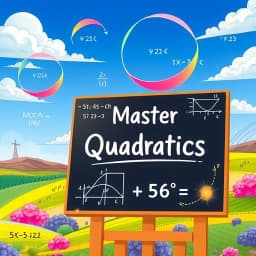
How to Write a Quadratic Function in Standard Form
Find this useful? Bookmark ( CTRL/CMD + D ) for quick access!
Try an example:
Standard Form Conversion
Graphing Quadratics
Real-World Applications
Vertex Form Transformation
Factoring Quadratics
Quadratic Word Problems
Explore Similar Tools
Recent Generations
the amount paid directly to you. Yes it is possible in future cases to request direct payment to the provider, Rephrase and give me polished email.
we have processed the claim as per the attachments in the claim submission we have processedthe invoice for Saul Holding. We dont have invoice for the Salofalk.
this additional information is very important. this adiitional information was requested by our clinical team. Without clinical review claim not be paid so please share the below additional information
How To Write A Quadratic Function In Standard Form
How To Write A Quadratic Function In Standard Form is a powerful AI-powered educational tool that helps users master the art of writing quadratic functions in standard form. This innovative solution combines advanced algorithms with user-friendly interfaces to deliver clear, step-by-step guidance for students and educators alike.
Key Capabilities
- Step-by-Step Instructions: Provides detailed explanations on converting quadratic functions into standard form, ensuring users grasp each concept thoroughly.
- Interactive Examples: Engages users with real-time examples that illustrate the process of writing quadratic functions, enhancing understanding and retention.
- Practice Problems: Offers a variety of practice problems to reinforce learning, allowing users to apply their knowledge and gain confidence in their skills.
- Instant Feedback: Delivers immediate feedback on user inputs, helping learners identify mistakes and correct them on the spot.
Who It's For
Designed for students, teachers, and anyone interested in mastering quadratic functions, How To Write A Quadratic Function In Standard Form excels in educational settings. Whether you're a high school student preparing for exams or a teacher looking for effective teaching resources, this tool streamlines your learning experience and enhances productivity.
Why Choose How To Write A Quadratic Function In Standard Form
What sets How To Write A Quadratic Function In Standard Form apart is its intuitive design and comprehensive approach, making it the ideal solution for anyone struggling with quadratic equations. With its focus on clarity and user engagement, this tool addresses the common challenges faced by learners in mathematics.
Ready to transform your understanding of quadratic functions? Start using How To Write A Quadratic Function In Standard Form today and experience the difference in your mathematical journey!
Enhance Your Work with How to Write a Quadratic Function in Standard Form
Leverage the power of AI to streamline your tasks with our How to Write a Quadratic Function in Standard Form tool.
Step-by-Step Guidance
Receive detailed instructions on how to convert quadratic functions into standard form, ensuring a clear understanding of the process.
Interactive Examples
Explore various interactive examples that illustrate the conversion of quadratic functions, enhancing your learning experience.
Instant Feedback
Get immediate feedback on your attempts to write quadratic functions in standard form, helping you to improve your skills effectively.
How How to Write a Quadratic Function in Standard Form Works
Discover the simple process of using How to Write a Quadratic Function in Standard Form to improve your workflow:
Identify the Quadratic Function
Start by identifying the quadratic function you want to convert into standard form, typically in the form of ax^2 + bx + c.
Collect Coefficients
Gather the coefficients a, b, and c from your quadratic function to prepare for conversion.
Convert to Standard Form
Use the formula y = a(x - h)^2 + k to rewrite the quadratic function in standard form, where (h, k) is the vertex.
Verify the Result
Double-check your converted function to ensure it accurately represents the original quadratic function in standard form.
Use Cases of
How to Write a Quadratic Function in Standard Form
Explore the various applications of How to Write a Quadratic Function in Standard Form in different scenarios:
Educational Tool for Students
Assist students in understanding how to convert quadratic functions into standard form, enhancing their algebra skills.
Curriculum Development for Teachers
Provide teachers with resources and examples for teaching quadratic functions, ensuring a comprehensive understanding of the topic.
Graphing Calculator Integration
Integrate with graphing calculators to help users visualize quadratic functions in standard form, aiding in better comprehension of their properties.
Real-World Problem Solving
Help users model real-world scenarios, such as projectile motion or profit maximization, using quadratic functions in standard form.
Who Benefits from How to Write a Quadratic Function in Standard Form?
AI-Powered Efficiency
From individuals to large organizations, see who can leverage How to Write a Quadratic Function in Standard Form for improved productivity:
Students
Learn how to write quadratic functions in standard form for better understanding of algebra concepts.
Teachers
Utilize the tool to enhance lesson plans and provide clear examples for students learning quadratic functions.
Mathematicians
Streamline the process of converting quadratic equations to standard form for research and analysis.
Tutors
Assist students in mastering quadratic functions with practical examples and step-by-step guidance.
Frequently Asked Questions
What is a quadratic function in standard form?
A quadratic function in standard form is expressed as f(x) = ax^2 + bx + c, where 'a', 'b', and 'c' are constants, and 'a' is not equal to zero.
How do I convert a quadratic function from vertex form to standard form?
To convert from vertex form, which is f(x) = a(x - h)^2 + k, expand the equation and simplify it to the standard form f(x) = ax^2 + bx + c.
Can the tool help me graph a quadratic function?
Yes, the tool can assist in graphing a quadratic function by providing key features such as the vertex, axis of symmetry, and intercepts based on the standard form.
Is there a specific method to find the coefficients a, b, and c?
Yes, you can find the coefficients by identifying the values from the standard form equation or by using methods such as factoring or completing the square.
What if I have a quadratic function in factored form?
If your quadratic function is in factored form, such as f(x) = a(x - r1)(x - r2), you can expand it to find the standard form by multiplying the factors and combining like terms.
































